FICTION
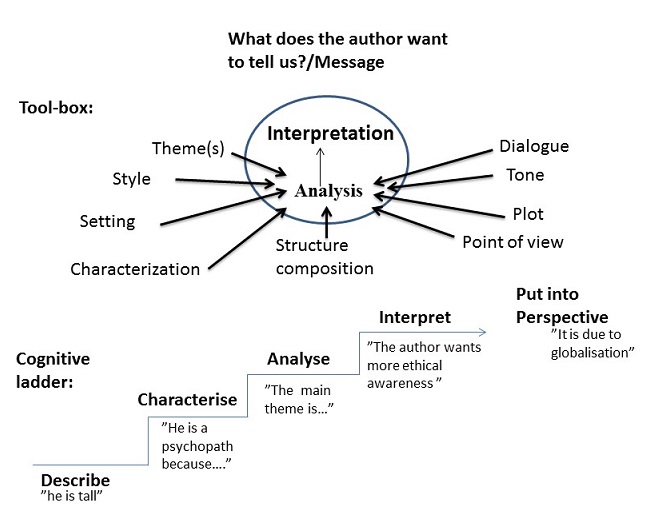
Note: Examples (taken from
Premium Harmony): Plot: Mary suffering a heart attack in the supermarket. It
triggers a lot of action, through which we learn a lot about Ray and his
relationship to Mary.Tone: Ironical – even satirical – in its criticism of the
American way of life, the materialism, the accomplishment of superficial
happiness through material consumption. Structure: Logical progressing action
along a time line. Themes: Obesity. Materialistic consumption. A love-less
marriage. Provincial, small-town America, in the midst of economic recession,
and dominated by in-authentic values. Big business dominates the town (“Wally
World” and Wal-Mart having its own stoplight).
In literary
analysis you often use the
following terms:
|
Setting: |
Where does
the story take place? May include location, era / epoch: time period,
time of day, weather, social atmosphere, housing and other
socio-economic conditions (are people rich or poor?) |
|
Narrator: |
Person
telling the story. Usually this one is different from the author (that
is, the author “tells the story” through the narrator) |
|
Character |
Do
characterisation, that is: analyse the
characters or the main character |
|
Composition: |
The
structure of the story (how is the story composed – make a timeline of
events?) |
|
Plot: |
The
“action” of the story |
|
Plot curve: |
Rise and
fall of action/inaction. Rising tension/conflict, falling
tension/conflict. Resolution at the end? |
|
Point of
view (POV): |
Who tells
the story: 3rd person or 1st person narrator?
Omniscient (all-knowing) narrator who may pop in and out of people’s
minds and knows everything about what characters think and the
anxieties they have, - or is it a more limited 3rd person
who tells the story from one character’s perspective? |
|
Dialogue: |
The author
may want to give us information about the characters through their
conversation. From the way they talk we, as readers, deduce information
about them. It may also be a way to give background/historical
information in a smarter way than the heavy encyclopedic way. |
|
Theme(s): |
What is the
main topic(s). For instance love/hate, war/peace, poverty,
etc |
|
Message: |
What does
the author want to tell readers? Is there a moral, an ethic, and/or a world view? |
|
Protagonist/antagonist: |
The first
one is the character you, as a reader, is supposed to side with, the
other one is the opposite character, the opponent. |
To make an
analysis of the text, you combine them in various ways, cf the figure
below.
For instance when you analyse the dialogue in the text, you infer from
the
dialogue character traits of the main characters. They reveal who they
are
through the way they speak and what they say.
An example:
A piece of text taken from Stephen King’s short story Premium
Harmony (The New
Yorker Nov. 9, 2009), which
tells the story about the janitor Ray
and his wife Mary, who live in the fictional town of Castle Rock in
Maine
(setting):
“Then another year goes by and we’re still there,” she says.
“We can’t wait
another year, Ray. We’ll be bankrupts.”
When she talks, Biz looks at her from his place in the back
seat. Sometimes
he looks at Ray when Ray talks, but not always. Mostly he looks at Mary.
“What do you think?” he says. “It’s going to rain just so
you don’t have to
worry about going bankrupt?”
“We’re in it together, in case you forgot,” she says.
They’re driving
through Castle Rock now. It’s pretty dead. What Ray calls “the economy”
has
disappeared from this part of Maine. The Wal-Mart is on the other side
of town,
near the high school where Ray is a janitor. The Wal-Mart has its own
stoplight. People joke about it.
“Penny wise and pound foolish,” he says. “You ever hear that
one?”
“A million times, from you.”
He grunts. He can see the dog in the rearview mirror,
watching her. He sort
of hates the way Biz does that. It occurs to him that neither of them
knows
what they are talking about.
“And pull in at the Quik-Pik,” she says. “I want to get a
kickball for
Tallie’s birthday.” Tallie is her brother’s little girl. Ray supposes
that
makes her his niece, although he’s not sure that’s right, since all the
blood
is on Mary’s side.
“They have balls at Wal-Mart,” Ray says. “And everything’s
cheaper at Wally
World.”
“The ones at Quik-Pik are purple. Purple is her favorite
color. I can’t be
sure there’ll be purple at Wal-Mart.”
They are on their way to Wall Mart to buy grass seed. Through the
dialogue we
learn that their financial situation is rather strenuous, partly due to
the
financial crisis of 2007-9, during which a lot of American home owners
got
close to financial ruin. The setting is small town America, and an
important
theme is how this affects the characters. Through the dialogue we get a
sense
of Mary being the sensible one. Ray is shying away from the work with
the lawn,
and she is reasoning with him: “We cannot just wait for the rain”. She is tired of listening to his clichés
(“penny wise and pound foolish”, which she has heard a million times).
The dialogue
cannot give all the information. We’re supplied with background
information
about Tallie. Events are seen from Ray’s perspective (point-of-view):
“Ray
supposes that makes her his niece” – but family matters don’t seem to
be his
strong side.
Like many old married
couples they
argue about trivial matters, in this case whether balls are cheaper at
Wal-Mart
or Quik-Pik.
It irritates Ray that
the dog seems
to be more attached to Mary than to him (is he even slightly jealous?):
He can see the dog in the rearview mirror, watching her. He
sort of hates
the way Biz does that.
The story can be
considered a kind of morality tale. The author tells a story of the obesity
epidemic through Ray’s and Mary’s life. The author’s message is: Don’t live
that kind of life, be more authentic in your love relationships and the way you
communicate with people around you. Ray is dishonest in his dealings with
people around him. He regards attractive women as potential “easy lays” and he
stays in a marriage he is fed up with.
A short story may be very short or very
long. Generally, however, a short story is neither very short, nor long.
Being a short story it wants to convey
its message or excitement/thrill in a rather compressed form. It is not like
the novel, which is so long that more detailed character analysis and deeper
exploration of themes can be made.
Text:
|
For sale: baby shoes, never worn. – Ernest Hemingway |
The text in the box above is probably the shortest short story in the history
of literature. It does not contain many of the items mentioned above. There is
no character, no plot, no dialogue, etc. And yet it is quite a powerful story,
because it turns the reader’s imagination on. You cannot help wondering: What
happened to the baby, - did something sinister (perhaps death) happen to it?
And what about the parents – how do they feel about it? So, in a way this story
is unfolding in the reader’s mind.
|
Text: Two cousins were travelling through Montana, and were rightfully
astounded by the grandeur of the state, which is beautiful in hundreds of
places, always living up to its name, which was taken from a novel by
Vonnegut. The cousins were stopped at a roadside cafe called The Roadside
Cafe, where the food was not bad, and they were eating pie and talking about
drugs. One of the cousins said this: "I'm amazed that I'm 47 and I still
haven't tried any drugs." This cousin, Dennis, never preached against
drugs to others; he simply hadn't had much interest in drugs himself, and
hadn't ever bothered. "Well," said the other cousin, whose name was Maura, "I
guess I've done enough drugs for the both of us." Dennis cocked his head
to the side. "What drugs have you taken?" he asked. Even while he
asked this question, he was uneasy, because he had a very definite feeling
that if Maura had taken lots of drugs, and dangerous drugs, he'd feel
different about her, and he liked the way he felt about her at the moment.
"You name it," Maura said. "Coke, LSD, shrooms,
everything." Dennis looked away from Maura and down at his food. Though
none of the substances she named held appeal for him, he could stretch his
brain and almost understand the trying of these particular drugs. But he had
never known anyone who had tried the one major and remaining, as-yet-unnamed
drug. Dennis feared that Maura had tried this other drug, the one whose very
name gave him the same chill he got from words like lynching, carcass and
fish-gutting knife. Had she tried it? Should he ask? Of course not, but of
course he would, and he knew that if she answered in the affirmative, he
would want to shake and weep, because it seemed like such an immeasurably sad
thing to do: for him it was like the building of a dungeon below one's
kitchen, or the piercing of one's penis. "I tried heroin once," Maura said, when Dennis asked, and
her words blasted through him like buckshot. His eyes were suddenly wet and
his limbs seemed hollow. "I just snorted it, though," she added.
"I'd never inject it." Dennis said nothing, because he had to spend
some time thinking about why this news made his eyes feel such strain, and
why he wished he were alone in Montana, going the other way, perhaps in a
plane. |
The story above is also very short. Actually, it belongs to a genre called a
short short story.
The story is set in Montana, a mountainous state in the United States of
America. It derived its name from the Spanish word montaña, meaning mountain
(the name of a character in the American writer Curt Vonnegut’s novel
Slaughterhouse Five. The dramatic theme is stressed by the story taking place
in Montana where some of the wars against the original inhabitants of America occurred. There is a contrast between
the savagery of the white settlers in the state in the second half of the 19th
century and the timidity of Dennis, the protagonist.
There are two characters, Dennis and Maury, who are cousins.
Point of View (POV): 3rd person limited, as the narrator is
only seeing things from Dennis’ point of view. From this POV we can see that
Dennis is a very cautious fellow. He is even afraid of very “menacing” concepts
like heroin.
There is not much of a plot in the story. Two cousins stop at a roadside
café in Montana and have a conversation about drugs. That is not a very
interesting plot. There is no thrill. The thrill is in Dennis’ mind. He is
thrilled by words describing things that border on what is abnormal, like
taking a dangerous drug. Likewise “lynching, carcass and fish-gutting knife”
make him shiver. He even feels potential castration at the thought of such
dangerous and “sad” phenomena. Dennis obviously is afraid of facing life itself
with its many potentially hurtful things and experiences.
The main theme is not drugs. It is
rather the existential challenge that Dennis is confronted with in the cousin’s
history of drug use.
Instead of enjoying the stay at the
roadside café with his cousin, Dennis wished “he were alone in Montana, going
the other way, perhaps in a plane”. It’s
meant to be funny, - and a bit ironic: “he could
stretch his brain and almost understand….”.
There is dialogue in the story.
It facilitates the author’s point, which perhaps (if there is any seriousness
in the story) is: Do not be fearful of life. Try it out! Take what it may give!
If it was not for the dialogue the message would appear too heavy. With the dialogue the message is served in a
light and humorous way. The Gender perspective adds to the fun: Who is the
fearful one? Who is the one who has tried the dangerous drug?
In many fictional stories, novels included,
the author uses the narrative method. Narration means story telling. How do you
tell a story so that it interests the reader to such an extent that this one
continues turning the pages. Often identification with the protagonist helps:
If the readers feels that he or she “is in the protagonist’s place, this helps.
This requires a character as protagonist that the reader wants to identify
with.
Freitag’s triangle
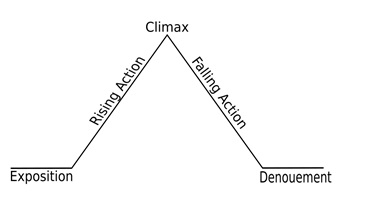
Gustav Freitag was a German writer in the
19th century who described the general pattern of making suspense in
a story.
There is a pattern of rising action, a climax
and falling action. It starts with an exposition where the reader is presented
with necessary background information. In the exposition there is very often a
presentation of the main conflict or tension in the story.It ends in the
denoument (French word meaning “resolution of conflict”).
Of course, this is not necessarily an
element in all stories, or one can find only some of these items. Many short
stories start in medias res (“right in the middle of event”, that is without
introduction). In the Dave Eggers story above the exposition is very short:
“Two cousins were travelling through Montana”). The next piece of expository
information is very short: “….and were rightfully astounded by the
grandeur of the state, which is beautiful….”
We see the landscape through the eyes of the characters and are
presented with their experiencing of it. In that way the setting is introduced
in a light way, and a way that tells us something about the characters.
The climax of These Two Cousins is Maura saying. "I tried heroin once,"
Maura said. The conversation leading up to it is the rising
action. Then the story fades out very quickly with the shock taking hold of
Dennis and his wishing he were alone.
However, in this story the main point
is not the method and procdure of the narration. The main point is the way the
two cousins, man and woman, experience the raw facts of life: that people are
different, and people close to you might have done things that are shocking to
you.
Fiction is based in the author’s imagined world.
Non-fiction is writing based in facts, real life, the real world.
But sometimes the distinction is blurred. That
is often the case in modernist and postmodernist writing. Today, many writers
view the dividing line between fiction and non-fiction as thin, artificial, or
even non-existent. Some writers use the same writing techniques in both:
…..when a writer
comes to a story, whether fiction or nonfiction, they employ many of the same
techniques, of narrative, plot, pace, mood and dialogue. This is one reason I
think the distinction between fiction and nonfiction … is, well, a fiction.
(Aminatta Forna,The Guardian Dec 6 2015)
Postmodernist writers often want to break with
the illusion of “the imagined world looking
real”, when the realistic author has created look-alike characters that
he or she moves around on the stage which is a look-alike replica of the real
world stage. Postmodernist writers want to break this illusion in order to show
how contingent everything is: It happens, or has happened, but something else
might just as well have happened. The scope for choice is infinite. Identities
are constructed, and they may be reconstructed.
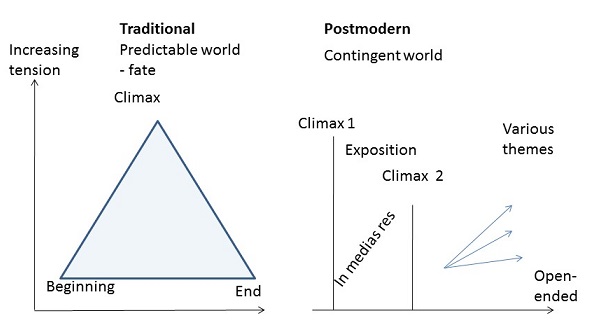
There may be several endings, and the reader
may have the option to choose one ending - or the option to continue
writing the story.
|
|
NON-FICTION CODES |
FICTION CODES |
|
Intention |
Inform, document, argue,
encourage, debate |
Entertain, express different
ways for people to establish personal/social/ cultural identity… |
|
Sender – Receiver |
The text is to be seen as depicting actual
events, people, things. It is factual |
The text is to be seen as
dealing with imagined phenomena. It is fictitious |
|
Relation to reality |
I think and write –
therefore I am Takes its starting point in
and tries to represent reality. Literal relationship to
reality (ideally shows a representation of reality) Objective |
What I say/write is a
construct. It is a figment of the imagination Inspired by reality, but not
obliged to represent reality as “it is” Metaforic/symbolic relation
to reality (shows an interpretation of reality) Subjective |
|
Message |
Often outspoken and
unambiguous (utvetydig), for instance the political pamphlet or essay. People are presumably living
in real place and real time. There is a real environment and events are real |
Often concealed (skjult) and
ambiguous (tvetydig) |
- There is a real environment
and events are real. ….. At least that
was what we thought, the postmodernist might add.
NON-FICTION TEXTS
THE NEWS
ARTICLE
Text:
|
Inverted Pyramid
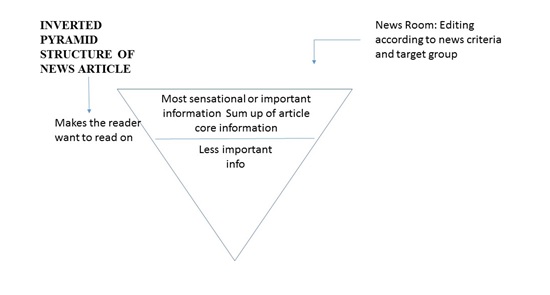
It deals with factual events. In some ways,
however, the text might appear fictional if we didn’t know it is an article.
There is more of a plot in this “story” than in the previous one.
There is not much description of character
in the story about the unfortunate priest. We only get factual information
about the characters. We are told what they do and what they say. But we can safely conclude that both of the
two main characters are very moral and ethically committed persons. They are
competing about what is the more ethical act: encouraging poor people to find
the “easy way” out of the most urgent poverty, or keeping young people out of
crime.
The article/story was printed because
it fulfills the news criteria: Something extraordinary happened, which makes it
interesting to a newspaper’s readers. It is newsworthy, because it happened not
so long ago. There is tension and a
dramatic conflict between Tim and Martin, which leads to a very unusual event:
The pouring of pasta on a priest. There is something controversial: The
priest’s sermon. (Compare how the
story is dealt with in The Daily
Mail).
Whenever you want to analyse a text, a film, a
speech, or anything else, it may be useful to see it through the lens of the
communication model.
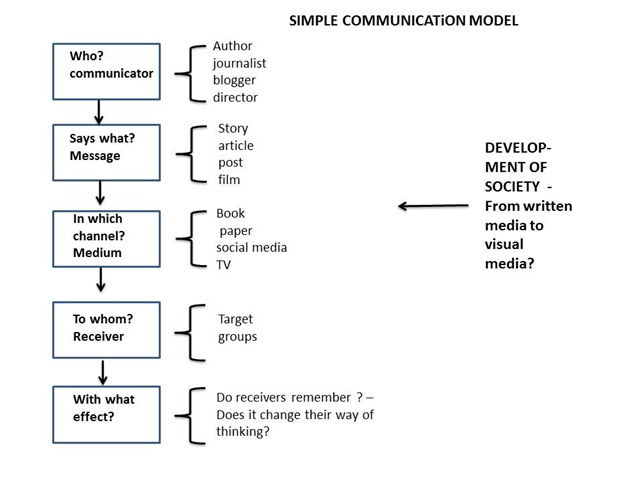
Above is a version of the simple communication
model. In the simplest form it may be A (communicator) saying something to B
(receiver). A’s message may be understood – or it may not be understood - by B.
It is understood if A speaks sufficiently clearly and sufficiently loudly. And,
of course, they must share the same language in order to understand each other.
When we read a short story, we may be aware of
the fact that the sender is an author and a publisher. The message (the short
story) may be encoded in such a way that it can be easily understood by almost
everybody, or it may be encoded in such a way that it is only understood by
those with a high education.
If the author wants to get on the best seller lists, he or she has to write in a code that is understood by many different people (target groups involve readers from various social backgrounds).
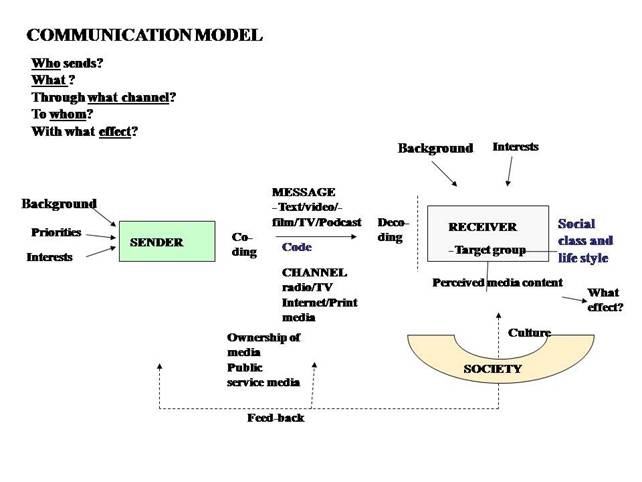
The complicated communication model can be
used to analyse how a message is transmitted from sender to receiver (the five
wh-questions may be answered), when society at large is taken into account.
Then we attempt to answer the question: How do the surroundings, technology and
other factors have a say in how the message is sent and to what extent it is
received.
Take the news article about the priest
encouraging poor people to shoplift. The sender is the journalist, who wrote
the piece, and the newspaper The Guardian.
The receiver is the readers of The Guardian.
And furthermore: The Readers of The Guardian online. It is generally considered
a “serious” paper with some left-leaning tendencies. So one may wonder why they
publish such an item of news?
The Daily Mail, which is a more sensational
paper, prints a longer article about it. It is more in line with this
paper’s editorial policy. In the Mail there is an ironic twist to the story. In
the title it says. Thou shalt shoplift….”, thus suggesting a kind of biblical
message (ten commandments!), but turning it upside down by writing it as an
affirmative title. There are more than
700 comments from readers. That means it has a considerable effect.
The two papers code the message,
which is the news article, differently. In The Mail there is a photo of the
priest. And the paper stresses the biblical connotations, thus perhaps
provoking more resentment and indignation among religious people.
Newspapers (in paper form and online)
are privately owned. They have to make a profit or avoid a deficit on the
bottom line in order to survive. Therefore sensational news is printed. But it
is dealt with differently in different types of media (compare local media, where there is even a transcript of the
priest’s sermon).
Rhetorical
Analysis (Example.)
Rhetorical analysis is used on speeches in
which the speaker tries to convince an audience that he or she is right. It may
also be used in other contexts when a writer, film maker og singer wants to
persuade people to accept an argument.
The following are some of the steps it may
be useful to go through:
1 How can you use the communication model
to see how the framing and putting the pessage depends on the communication
situation? That means: You may beging by answering the five wh-questions in the
simple communication model (Who sends to whom, etc.). You may proceed with a
more complex model: What is the target group (målgruppe)? How was the sender
influenced by his/her perception of the target group when encoding the message?
What is the primary target group
(for instance the audience in a lecture hall), what is the secondary (when the press and other media report it to the public
at large).
You may look on the speech as a text.
But you may also be aware of the speaker’s body language, mimicry and visual
background effects in media messages.
2 The speaker’s ethos, that is his or her
trustworthiness. How do the audience perceive the reliability of the person
speaking. Does he or her have academic credentials, respected titles, or other
attributes that evoke respect among the audience?
3 How is the speech/message composed? Is
there a logical structure that progresses from start, main body, to a
conclusion at the end? Or does the speaker hit at all flying targets in a more
or less chaotic way?
4 How does the speaker put forth arguments, and are these arguments logically
structure and supported by valid reasons and facts? Or does the speaker put
forth invalid arguments that are not reasonable and supported by verifiable
facts?
In other words: Does the speaker use Logos (rational and logical arguments
based on facts)? Does the speaker use pathos
(appealing to passion/emotions). Does the speaker use ethos (appealing to the trustworthiness and reliability of the
speaker by way of dress, titles, education, social status etc)?
5 How is the message coined? That is: Does the speaker use simple words and
sentences, or does he/she use a more complex language – subordinated clauses,
causal relations (because, as), and conditional clauses (if)?
Does he or she speak literally (bogstaveligt) or are metaphors (metaforer) or
other types of figurative language being used?
In an
analysis of argumentation you test the arguments of a speaker hold water. You
want to see if the arguments are valid, reliable and consistent.
Generally, a speaker makes some
claims (påstande) about something, and he wants to support the claims through
various types of arguments. For instance: “Most people vote for Candidate X. He
is a good man. He does not get money from Wall Street”.
It starts with a claim about people
voting for a certain politician in an election. Why? – because: “he is a good
man”.
The argument for voting for X
consists of (in the Toulmin model):
A claim
(påstand): People vote for X
A ground (belæg): He is a good
man
Backing of the claim: He does not receive money from firms in Wall
Street for his campaign
Warrant (hjemmel): It can reasonably be assumed that politician who do
not receive money support for their campaigns from big business are “good”
politicians.
Whether X is
actually a “good man” remains to be seen. Is “not receiving money from big
business” sufficient criteria for being a “good man”? – Hardly. To support the
argument we should need further evidence.
In a discourse analysis we want to explore a text/message for hidden power relationships. The hypothesis is that language is never completely objective. It is subjective. Even if you may want to base your message on facts, the way you choose among facts and how you describe them may reveal something about your personal preferences. Objectivity may be an ideal you want to pursue, and perhaps you succeed to some extent. But it is impossible to be a one hundred per cent objective. Bias may sneak in in a variety of ways.

A discourse consists of a core concept, for instance
democracy, free market, freedom. And then there a concepts, words that support
this key concept in chains of equivalent signifiers.
In the following excerpt from a speech given by Labour leader Jeremy Corbyn the nodal
point is justice
We celebrate the values of solidarity,
of compassion, of social justice, fighting for the under-privileged, and of
working for people at home and abroad.
Whilst we value and protect the rights that we have in this country, the
same thing does not apply to trade unionists all over the world. Those people that died in that dreadful fire
in China where there was a free market philosophy around the operation of a
port, fire-fighters died trying to protect other workers who should have been
protected by decent health and safety conditions…… Source: https://www.tuc.org.uk/about-tuc/congress/congress-2015/speech-leader-labour-party-jeremy-corbyn-tuc-annual-congress .
Justice is a
floating signifier. It is a word that may take on a multiplicity of meanings,
according to the context and how it is articulated in communication. In this
case the chains of equivalent signifiers give it meaning in the concrete
articulation. It is “social justice”. The speech is given at a congregation of
trade unionists. This helps to explain the meaning of the word solidarity. A
group of home owners also want to show solidarity to each other to help develop
the value of their property. In this case, however, it is working class
solidarity, between members of the trade union and to other members of society,
particularly other workers. “Free market”, which may be a positive term in the
words of liberalists, is in this context given a negative meaning by the use of
“philosophy” and the context of a work related accident in the Chinese port.
The ideological content is furthermore stressed by the
choice of facts and value terms, and the contexts in which these are used.
|
Factual Terms |
Value terms |
|
Fire in Port in China |
Solidarity compassion |
|
People died |
dreadful |
|
This country |
Under-privileged |
|
Fire fighters tried to protect workers |
decent |
An Example:
“The Big Society” – construction of a new discourse
In 2010 the Conservative political leader
David Cameron tried to convince the British people that a new discourse for
society was needed. It was not enough any longer to be conservative in the
traditional way, i.e. basing your conservative beliefs in the notions of
tradition, royalty, “Britishness”, and long-cherished conservative valutes. A
new direction for Britain was needed. And when he won power at the general
election in 2010 he wanted to impugn the narrative of “the big society” on
Britain.
He delivered a speech in Liverpool, one of
the “troubled cities” of Britain at the time. In the speech he talked about
“broken Britain” and how it had to be mended through his vision of the “Big
Society”.
Figure
: Wordle of Big Society Speech
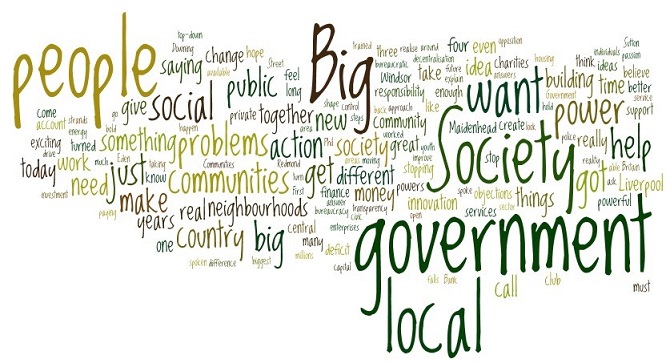
In a wordle the frequency of words being used
is counted and the result can be seen (figure above). The most frequently used
words and phrases may reflect the dominant discourse – or parts of it. You can
also use the website www.wordclouds.com (click on file and paste text. There is in
this site also a wordlist menu in which you can see the frequencies of words
being used, and you may edit by removing words).
First of all, we can se that “society” and
“local government” are frequently used expressions in the text. For Cameron it
is important to stress that we live in a society, and we have local government
to help run and manage society. He does not share the former conservative
leader Margaret Thathcer’s notion “that there is no such thing as society” (meaning, in the final analysis, that we are
perhaps isolated, atomized individuals competing with each other in the market
place).
In a discourse we look for key words that
reveal what the discourse is about.
|
Discursive construction of “big society” Key words (nodal points): Words that constitute the
discourse and give meaning to other conceptes, for instance “big society”
gives a certain (new) meaning to (local) government (government no longer
top-down, but rather bottom-up). In this way Cameron has given a certain
meaning within his discourse to the term “government”. It is no longer the
distant ministry (Westminster), but something that is close to the citizen. “But before I get into the details, let me briefly
explain what the Big Society is and why it is such a powerful idea. You can call it liberalism. You can call it
empowerment. You can call it freedom. You can call it responsibility.
I call it the Big Society. The Big Society is about a huge culture change… …where people, in their everyday lives, in their homes,
in their neighbourhoods, in their workplace… …don’t always turn to officials, local authorities or
central government for answers to the problems they face … …but instead feel both free and powerful enough to help
themselves and their own communities. It’s about people setting up great new schools.
Businesses helping people getting trained for work. Charities working to
rehabilitate offenders.” |
Opponents to Cameron might argue that his discourse is about saving money for
the public purse. The welfare state has become too costly for the taxpayers to
continue supporting it. So we might as well try to find another way. And the
big society may be appropriate as a way to tell people that they must be a lot
more effective in helping themselves – in their families and their local
communities.
On the other hand Cameron does not want it to
be a saving exercise – at least this is not the way he puts it in his speech.
Reality may prove the opposite. But until that is the case we must take his
words at face value.
In discourse analysis you may be interested in
key words and words that operate as so-called “floating signifiers”. These are
words that change their meaning with the various contexts in which they may be
used.
Discursive Social Constructions
We have already seen how “society” was used
very differently by a former conservative leader, compared to how Cameron uses
it. To him it is a positive term, signifying the fact that we are connected in
a society, and that there is hence a measure of solidarity among the members of
a society.
In discourse theory society is a discursive social construction. In the sense
the word has been used here we cannot see a concrete representation of it. It
is not like a stone we see lying in the street. It is a concrete thing and we
use the word “stone” to denote it.
“Society” is not a concrete thing
that we can see. It consists of institutions, people, and relationships, and,
most importantly, it changes “form” and substance according to who use the
term, and how they use it. But that also
implies that it changes its content according to how the speaker wishes to
construct it.
This applies to a number of terms, for instance “democracy”, “love”,“gender”, “justice”
and “faith” (tro). That means that we are constructing society
through the way we are talking about it.
Short story
Narrativ method
Fiction versus Non-fiction
Inverted Pyramid
Communi-
cation model
Rhetoric
Argumentation analysis
Discourse Analysis